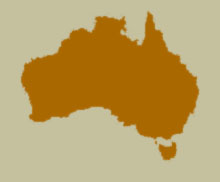Synonyms
Serangium magnum Slipinski and Burckhardt, 2006: 43.
Diagnosis
The large size, the relatively flattened body, the 8-segmented antenna and the elytral epipleura with hardly impressed cavities of S. magnum are unique among Australian Serangium.
Description
Length 2.1-2.7 mm. Winged; body shape hemispherical; pronotal margins visible from above, not rimmed except posteriorly; elytra with conspicuous swelling near humeral edge; elytral margins with fine rim, entirely visible. Light brown to black dorsally, reddish brown ventrally; head, pronotum laterally and elytral margin reddish brown; tibiae and tarsi dirty yellowish. Head, pronotal and elytral surface shiny; head impunctate, covered in long sparse setae. Pronotum very finely covered in sparse punctures and long sparse setae. Scutellum elongate, triangular, flat, shiny, glabrous. Elytra very finely punctate with a few long setae in basal fifth and a row of evenly spaced setae along margin. Head with moderately large eyes, separated by 1.9 times eye width; flattened medially. Clypeus flat, long, straight anteriorly. Terminal maxillary palpomere moderately broad, oval, obliquely truncate apically, terminal labial palpomere narrow and aciculate. Antenna 8-segmented, scape expanded apically, club elongate, inner margin convex, apex blunt. Prosternum mat, surface weakly furrowed, sparsely setose; mesosternum shiny, impunctate; metasternum shiny, sparsely setose. Elytral epipleuron reddish brown, broad, strongly inclined to elytron in anterior half, with a row of densely spaced setae, evenly narrowing towards elytral apex. Anterior margin of profemur strongly angled, protibia exceptionally broad. Tarsus 4-segmented. Abdomen: ventrite 1 large, shiny, impunctate, sparsely setose; ventrites 2-5 small, mat and bearing a few long setae, ventrite 5 densely punctured and setose. Last ventrite not grooved laterally.
Male
Male genitalia as figured.
Female
Externally identical to male.
Variation
Not observed.
 Distribution and Biology
Distribution and Biology
Widely distributed in northern part of Australia and New Guinea.
Species References
Slipinski, A. and Burckhardt, D. 2006. Revision of the Australian Coccinellidae (Coccinellidae). Part 5. Tribe Serangiini. Annales Zoologici (Warszawa), 56(1): 37-58.
[ Top ]
